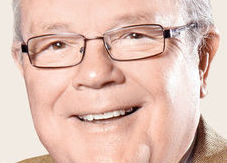By Peter W. Wagner
There’s times when producing a community paper can seem like being in a circus. One moment you are the acrobat balancing your way across a high wire and the next you’re the featured clown.
 I learned, while attending seminars in Massachusetts recently, that the small tent and arena circus and community papers have much in common.
I learned, while attending seminars in Massachusetts recently, that the small tent and arena circus and community papers have much in common.
The revelation hit me during a panel discussion featuring four of the nation’s leading small show circus producers. You probably wouldn’t recognize any of their names, but the panel included former Ringling stars Jeanette Williams and Bello Nock. Both can trace their roots back to family-owned European circuses.

What immediately drew me into the discussion were the opening words of the first speaker: “The circus is not dead,” he shouted passionately to the crowd. He went on to say that public perception was there was little or no interest in the circus now that Ringling Bros. and Barnum & Bailey, often referred to as “the big one” had closed.
His statement echoed that of the similar uneducated “Newspapers are dead” cry we often see hurled at our industry. A statement that is often followed with examples of huge metro papers closing or cutting back.
Outside pressures and single-minded organizations are making major changes to the circus, the producers agreed. Today’s audience doesn’t seem to want animals in the circus, for example. But Cirque Du Soleil’s many productions with their central storyline and human performers are attracting huge crowds.
The performance program may have changed, the producer’s agreed, but those who love the human desire for live performances and work in the business “have an obligation to see that the circus survives.”
And the same is true of the publishing business. Our audience may have changed, and a generation may even have seemingly turned in other directions for their limited news, but the majority of people living in most local communities still want and embrace their hometown paper. Like those individuals struggling to maintain the circus, we who love the printed paper have an obligation to keep it going.
Making it in the circus world, the producers said, is simply a question of supply and demand. The closing of RB&BB can be seen as an opportunity by some. That two-headed giant, the red and blue units, often exhausted a family’s available entertainment budget for that kind of entertainment. The absence of Ringling in metro communities promises greater audiences for shows playing smaller towns and the rural areas.
In the same way, metro papers reducing their number of publication days or area of distribution opens new opportunities for hometown publishers.
Four key points
But here are the four key points of the circus producer’s message. It could be a survival treatise for all of us in the publishing business.
- “We need to find new options for the circus,” one stated. “If we can’t attract a following with elephants and tigers what should we feature?”
- “We have to give consideration to packaging,” said another. “The theme, costuming, lighting, music and spectacle is as important as the content.”
- “We must return to what the circus once was,” was a third comment.
- “Attending a circus is still about adding quality to life,” shared another.
I sat there with my heart warming as I heard suggestions for the revival of the circus that also apply to our publishing industry.
Like the circus, we need to find new editorial and revenue options. Many local publishers are growing their online and social platforms, but those are not creating the financial return possible from a well-supported newspaper.
To that end, we must revise our content and coverage to provide the information most important and interesting to our subscribers. That means less canned news releases and more original hard news coverage of the local government agencies, sports coverage, school news, business news and well-written pieces on local people and places.
Packaging, too, is a must if local newspapers are going to survive and grow. The number one reason readers give for preferring a printed paper over the internet is the convenient gathering together of material. Subscribers can find the information they want — sports, social news and council news — nicely edited and interestingly presented in the printed paper. More importantly, the pages are designed in a way that draws the reader into the material with many re-entry points that keeps the reader interested. With the internet, it is sometimes necessary to search for the information desired and there is often a question of credibility.
Plus, like the circus, we must find ways to return to what the local paper once was. The community paper was the first social media with tidbits of who had Sunday dinner with friends or relatives and who was visiting in town. The hometown paper has always been the only source of detailed information regarding the local school, sports team, church activities and local government issues. Community papers have to truly dig into all that is “local” if the publishers expect to hold on to their readership.
The same is true about advertising. We, as an industry, have sometimes outpriced our value and expected more of our advertisers than we should. In the current multimedia mix and growth of small ad agencies, we must present our story clearly and boldly, offering easy to understand and use promotions at prices smaller advertisers can afford.
The community’s quality of life
But the best statement I heard at the circus seminar was the one about maintaining the “quality of life.”
The local newspaper is the sounding board of the community sharing balanced ideas from all sides. It is the community cheerleader promoting growth, wise decisions and family values. It is the watchdog, making sure those in authority live up to the standards expected of elected officials. It should have a passion for assuring a “quality of life” for all the people it serves.
What is true about the status of the circus and the community paper is equally true about many small, meaningful enterprises in our city. Many are facing the same threats from the big investors working the internet.
Perhaps some future loss from not being able to obtain goods and services locally will be reversed in the days to come. If so, it will probably be through the new local partnerships and local community marketing ideas.
But, to me, there will always be a need for the community paper. Too often I have seen when a community loses its newspaper everything else eventually seems to disappear.
We, who care about our industry, need to reinvent how the world sees and uses the newspaper.
 Nevada Press Association The best in Nevada journalism since 1924
Nevada Press Association The best in Nevada journalism since 1924
